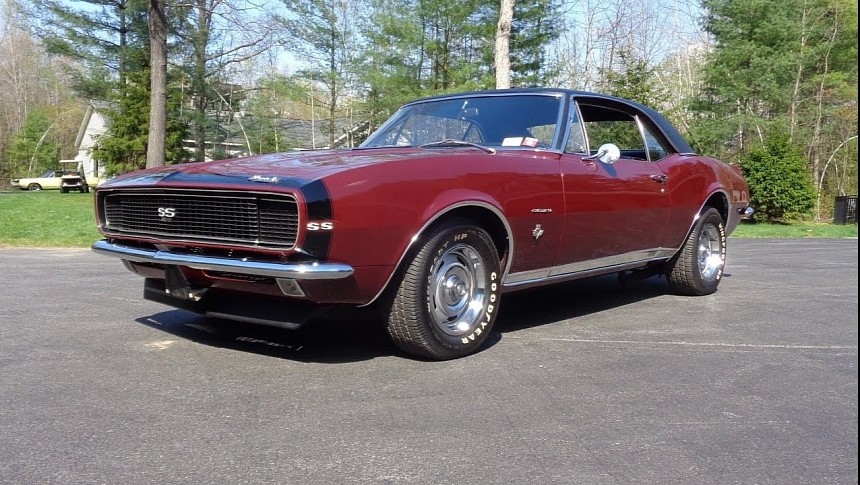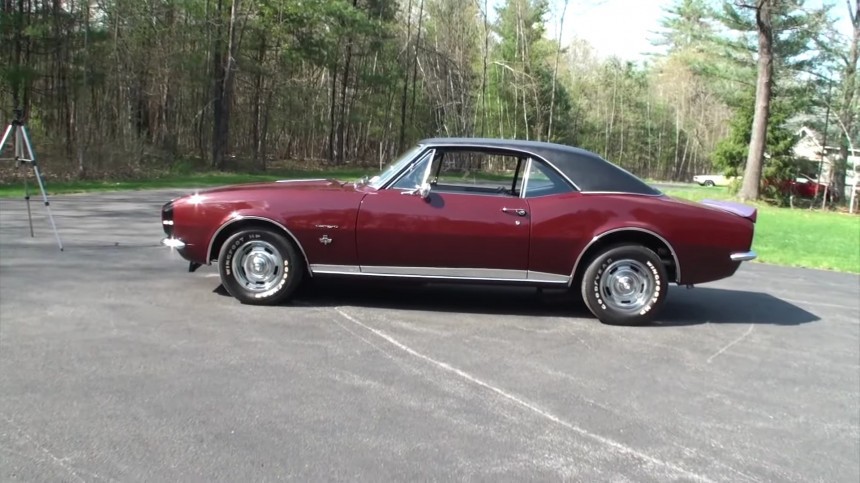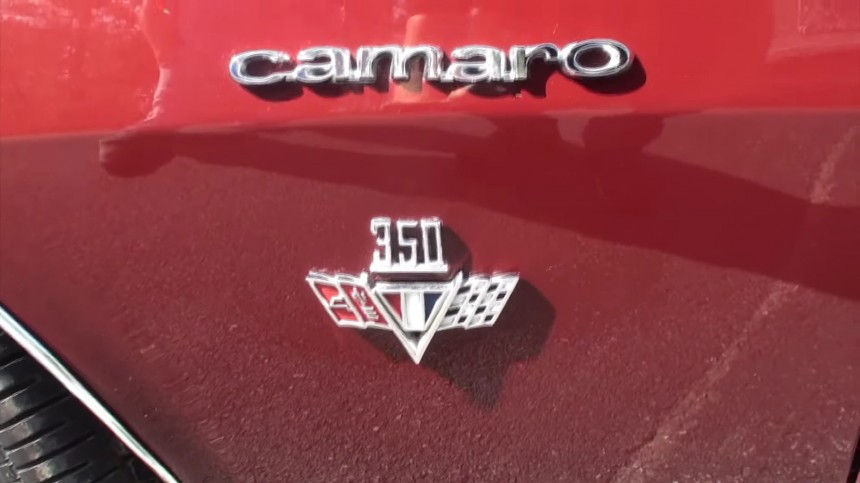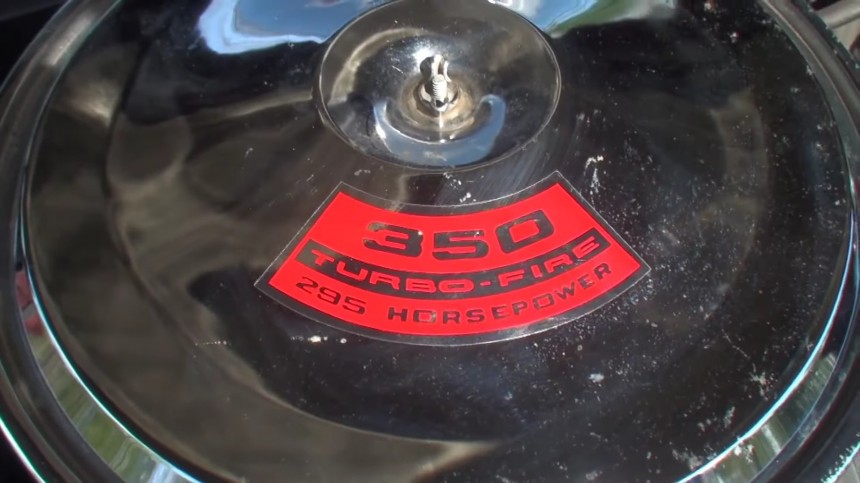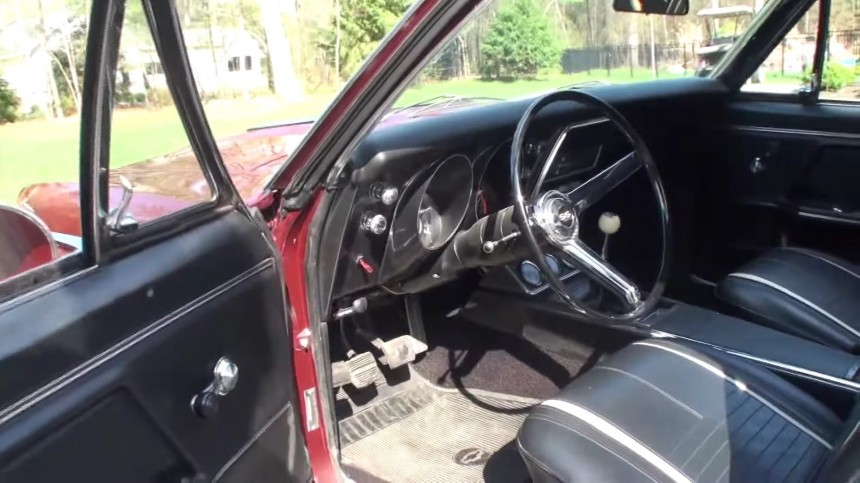Here's a challenge for only the proper-est gearheads, the hardcore muscle car fan clubs VIP members, and the ultra-fundamentalists of Detroit's motor realm: how many 1967 SS/RS Camaros were built? Right off the bat, I will admit I do not know the answer, but someone out there could shed light on this unsettling matter. Where did I get the idea? From one particular original, unmolested, numbers-matching example.
Why is it so vital for dwellers of Planet Piston that a car has – or has not – the factory-installed options, panels, parts, trims, and powertrain is beyond mere mortals' comprehension. But this is what makes or breaks a classic automobile in the razor-sharp judging of connoisseurs. And when one such survivor still runs and drives like day one, it's the big jackpot.
And there we have it – the all-correct first-generation-first-year Camaro that stars in this episode of Lou Costabile's YouTube video. The Madeira Maroon sport coupe with the black vinyl roof is the gift of the crank gods to the people of 2023. Although its owner refers to the livery as Burgundy, the trim tag reveals the correct hue.
Also, please note that the hood ornaments – an SS package giveaway sign - are incorrectly referred to as "ice cube trays." The name was coined for the '68 model because of its shape (four cube-like holes on each of the louvers). Regardless of the minor semantic inconsistencies, this primordial Camaro is a looker, thanks to the RS option.
The Rally Sport (the R and S) was an aesthetic improvement – and it had quite a visual impact – literally. The RS-equipped cars had no headlights – or so it appeared from a distance. Or from up close, for the untrained eye. One push of a button and the lamps would reveal themselves – while simultaneously turning on – from behind the hideaway doors.
Interestingly, the early RS cars had electric motors for the lights' flaps, which was quite a headache for General Motors. The actuators weren't exceptionally reliable, and warranty issues poured in over dealerships. Eventually, a recall campaign converted the cool feature to vacuum operation for all faulty RSs.
The exact number is probably buried somewhere in the Chevrolet archives – right along the figure revealing the SS/RS bundle. 64,842 Camaros drove out assembly plants adorned with the Rally Sport goodies (although none had anything to do with rallying and weren't sporty).
The back-up lights under the rear bumper were another telltale of RS, and the car would have bragged with its rebellious, no-bowtie black grille that sported the special badging. The letters were stacked vertically, but our hero had a different emblem.
It's the double S for Super Sport, and this was the real deal for the 1967 Camaro, the speed and thrills machine to "eat the Mustangs" (or so GM dreamt). 33,273 cars had the SS package option installed, and this choice wasn't just altering the garment.
While a regular Camaro offered eight engines during the first model year, the SS came with just two: the small-block 350 CID (5.7 liters) or the High-performance 396 CID (6.4 liters) big-block. The staple 350 was by far the preferred powerplant in ’67, with 29,270 units relying on its 295-hp gross power output and the 380 lb-ft of torque (299 PS / 515 Nm).
This car in our story is one of the automobiles that introduced the emblematic 350 V8 to the world in the L48-code build sheet engine option. Its original form featured a hydraulic cam, a four-barrel Quadrajet carburetor, and a 10.25:1 compression ratio. According to the owner, the motor, transmission, and rear end are factory-installed units.
The powerplant was an upcycled 327-cubes (5.3-liter) from which it inherited the small journal crankshaft. Also, thanks to the marketing frenzy of the era, the Turbo-Fire decals on the front fenders have nothing in common with forced induction – the V8 is naturally aspirated.
Regardless of the powertrain displacement, the SS transmissions were the four-speed close-ratio Muncie manual or the two-speed Powerglide automatic. The three-speed Turbo-Hydramatic was a mid-year add-on.
The current owner isn’t afraid to drive the car – and the video proves it – like it was meant to be driven. Much to his excitement, the Camaro was a pleasant matching-numbers surprise – although the prior seller didn't specify this feature when he traded it to the back-buying dealer. But, because the Chevy guy knows his cars, he had a Camaro expert inspect it before purchase. Here it is, almost two decades later.
Chevrolet aimed at two birds with one Camaro: to come up with something better than the Corvair and to join the feeding frenzy in the wake of Ford's Mustang selling success. While it made a good impression of itself and rendered its rear-engined Corvair into runner-up in the small-body segment internal Chevy hierarchy, the Camaro didn't outperform the Blue Oval wonder, not in the sales charts, even despite its almost immediate success on the racetracks.
Also, one small detail sets this car apart from the stock '67 RS/SS models – and it's not the aftermarket radio (the original is still with the car. It just sits in the trunk). The small switch on the left of the steering wheel is a mystery – including for the proprietor. Some viewers speculate it could be the fog lights on/off button, while others go for the anti-theft starter solenoid control switch speculation. However, this last version is a bit far-fetched – after all, a safety system mounted in plain sight and easily accessible isn't much of a reassurance against car thieves.
And there we have it – the all-correct first-generation-first-year Camaro that stars in this episode of Lou Costabile's YouTube video. The Madeira Maroon sport coupe with the black vinyl roof is the gift of the crank gods to the people of 2023. Although its owner refers to the livery as Burgundy, the trim tag reveals the correct hue.
Also, please note that the hood ornaments – an SS package giveaway sign - are incorrectly referred to as "ice cube trays." The name was coined for the '68 model because of its shape (four cube-like holes on each of the louvers). Regardless of the minor semantic inconsistencies, this primordial Camaro is a looker, thanks to the RS option.
Interestingly, the early RS cars had electric motors for the lights' flaps, which was quite a headache for General Motors. The actuators weren't exceptionally reliable, and warranty issues poured in over dealerships. Eventually, a recall campaign converted the cool feature to vacuum operation for all faulty RSs.
The exact number is probably buried somewhere in the Chevrolet archives – right along the figure revealing the SS/RS bundle. 64,842 Camaros drove out assembly plants adorned with the Rally Sport goodies (although none had anything to do with rallying and weren't sporty).
It's the double S for Super Sport, and this was the real deal for the 1967 Camaro, the speed and thrills machine to "eat the Mustangs" (or so GM dreamt). 33,273 cars had the SS package option installed, and this choice wasn't just altering the garment.
While a regular Camaro offered eight engines during the first model year, the SS came with just two: the small-block 350 CID (5.7 liters) or the High-performance 396 CID (6.4 liters) big-block. The staple 350 was by far the preferred powerplant in ’67, with 29,270 units relying on its 295-hp gross power output and the 380 lb-ft of torque (299 PS / 515 Nm).
The powerplant was an upcycled 327-cubes (5.3-liter) from which it inherited the small journal crankshaft. Also, thanks to the marketing frenzy of the era, the Turbo-Fire decals on the front fenders have nothing in common with forced induction – the V8 is naturally aspirated.
Regardless of the powertrain displacement, the SS transmissions were the four-speed close-ratio Muncie manual or the two-speed Powerglide automatic. The three-speed Turbo-Hydramatic was a mid-year add-on.
Chevrolet aimed at two birds with one Camaro: to come up with something better than the Corvair and to join the feeding frenzy in the wake of Ford's Mustang selling success. While it made a good impression of itself and rendered its rear-engined Corvair into runner-up in the small-body segment internal Chevy hierarchy, the Camaro didn't outperform the Blue Oval wonder, not in the sales charts, even despite its almost immediate success on the racetracks.
Also, one small detail sets this car apart from the stock '67 RS/SS models – and it's not the aftermarket radio (the original is still with the car. It just sits in the trunk). The small switch on the left of the steering wheel is a mystery – including for the proprietor. Some viewers speculate it could be the fog lights on/off button, while others go for the anti-theft starter solenoid control switch speculation. However, this last version is a bit far-fetched – after all, a safety system mounted in plain sight and easily accessible isn't much of a reassurance against car thieves.
